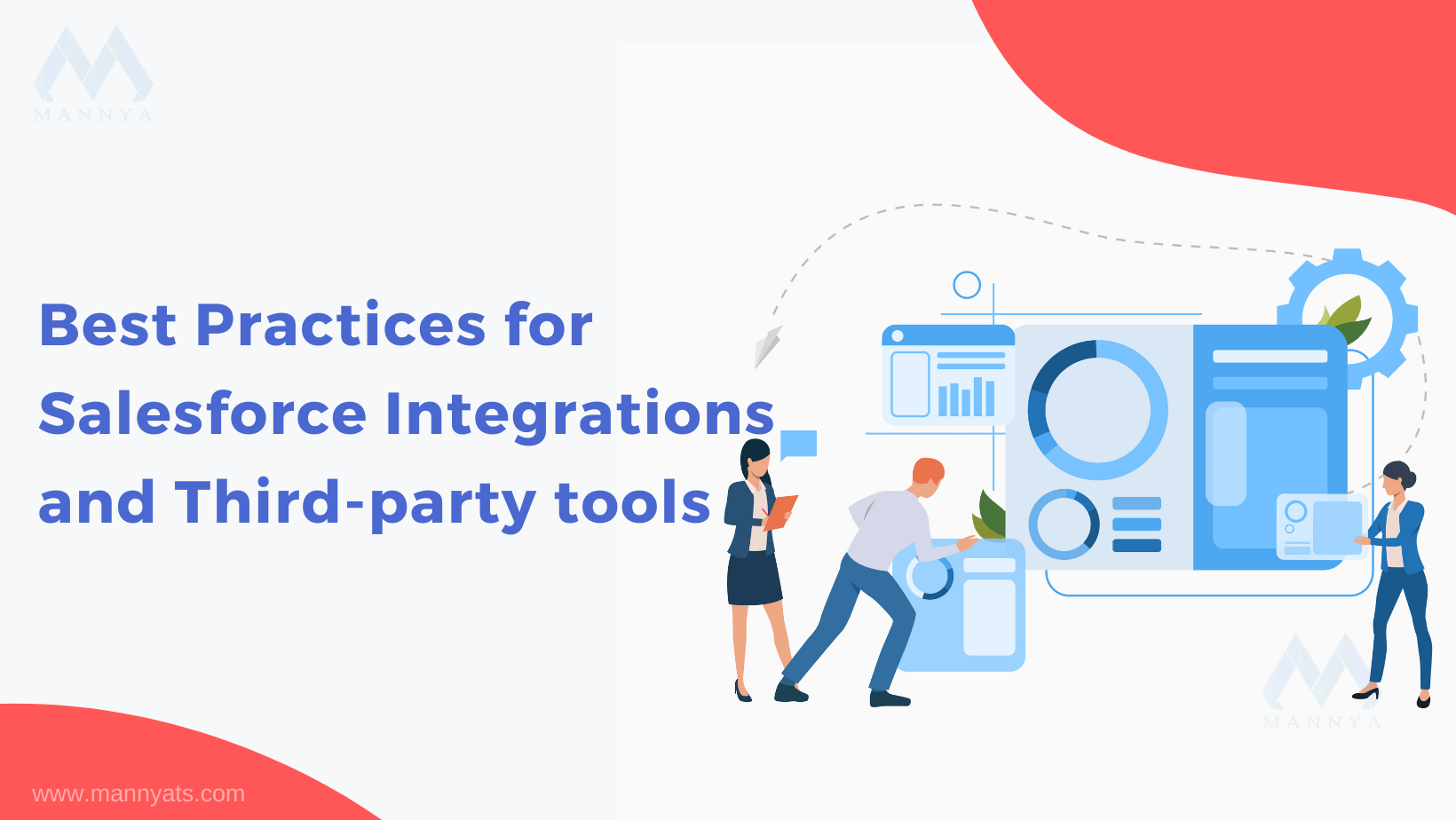Best Practices for Salesforce Integrations and Third-party tools
Salesforce is a powerful platform that empowers businesses to streamline their processes, manage customer relationships, and drive growth. However, the true potential of Salesforce can be unlocked by integrating it with third-party tools and applications. These integrations offer enhanced functionality, improved efficiency, and tailored solutions to meet specific business needs. In this article, we will delve into the world of integrations and third-party tools for Salesforce, exploring their benefits and various aspects.

Benefits of Integrations and Third-Party Tools
Extending Functionality: One of the key advantages of integrating third-party tools with Salesforce is the ability to extend its functionality. By integrating complementary applications, businesses can enhance their Salesforce experience and address specific requirements. Whether it’s integrating marketing automation tools, customer support systems, or e-commerce platforms, these integrations provide a seamless flow of information and improve overall operational efficiency.
Streamlining Data Management: Effective data management is crucial for any successful business, and integrating third-party tools can greatly assist in this regard. Integrations with data cleansing, enrichment, and deduplication tools ensure that your Salesforce database remains accurate, up-to-date, and free from duplicate records. This results in better insights, improved decision-making, and enhanced customer experiences.
Enhancing Sales and Marketing: Integrating Salesforce with sales and marketing tools unlocks a plethora of benefits. By connecting marketing automation platforms, businesses can streamline lead generation, nurture campaigns, and track marketing ROI. Integrating sales enablement tools provides sales teams with access to critical information, sales collateral, and productivity-enhancing features directly within Salesforce. These integrations empower businesses to optimize their sales and marketing efforts, boost conversion rates, and drive revenue growth.
Improving Customer Service: Integrations with customer support systems enable businesses to provide exceptional customer service. When Salesforce is connected with helpdesk tools or ticketing systems, support agents gain complete visibility into customer interactions, allowing for personalized and efficient assistance. This integration ensures that customer issues are promptly addressed, leading to improved satisfaction, loyalty, and retention rates.
Harnessing Business Intelligence: Integrating Salesforce with business intelligence (BI) tools empowers organizations to gain deeper insights into their data. These integrations enable data visualization, advanced analytics, and reporting capabilities, providing stakeholders with valuable insights to drive strategic decision-making. By combining Salesforce data with external data sources, businesses can uncover valuable patterns, trends, and opportunities for growth.
Customizing Workflows: Every business has unique workflows and processes. Integrations with workflow automation tools allow organizations to customize and automate their Salesforce processes to align with their specific requirements. These integrations enable businesses to automate repetitive tasks, reduce manual errors, and improve overall productivity.
Industry-Specific Integrations:
Many third-party tools offer industry-specific integrations tailored to meet the unique needs of businesses in particular sectors. Whether you’re in finance, healthcare, or e-commerce, there are integrations available that address specific compliance requirements, data regulations, and industry standards. These specialized integrations enhance the functionality of Salesforce, ensuring it aligns with your industry-specific workflows.
Best Practices for Integrating Salesforce
Clearly define goals and requirements: Before embarking on an integration project, it’s important to clearly define your goals and requirements, and determine what data and functionality you need to share between Salesforce and the other platform.
Choose the right integration method: There are many different integration methods available for Salesforce, including point-to-point integrations, middleware solutions, and API-based integrations. It’s important to choose the method that best fits your requirements and technical capabilities.
Ensure data accuracy and security: When integrating Salesforce with other platforms, it’s important to ensure that data is accurate and secure, and that the appropriate access controls are in place to protect sensitive information.
Test and Iterate: As with any development project, it’s important to test your integration thoroughly and iterate on the design based on user feedback and performance metrics.
Examples of Third-Party Tools for Salesforce
Marketing automation: Tools such as Marketo or Pardot can help businesses automate their marketing processes and deliver personalized experiences to their customers.
Help desk software: Platforms such as Zendesk or Freshdesk can integrate with Salesforce to provide a seamless customer support experience.
Analytics and reporting: Tools such as Tableau or Power BI can integrate with Salesforce to provide advanced analytics and reporting capabilities.
Data management: Platforms such as Data Loader or Jitterbit can help businesses manage their data in Salesforce more efficiently, and ensure data accuracy and consistency.
“While back in 2020, most companies (70 percent) said they were still tied to one cloud service provider, reports have found that 84% of mid-to-large companies will have adopted a multi-cloud strategy by 2023, positioning it as one of the year’s defining trends in cloud computing.”
In conclusion
Integrations and third-party tools play a crucial role in maximizing the potential of Salesforce. By seamlessly connecting Salesforce with other applications and systems, businesses can enhance functionality, streamline data management, improve sales and marketing efforts, deliver exceptional customer service, harness business intelligence, and customize workflows. These integrations enable businesses to optimize their Salesforce experience, increase efficiency, and drive growth. By exploring the vast ecosystem of integrations and third-party tools, organizations can unlock the true power of Salesforce and gain a competitive edge in their industry.
Why Mannya Techno Solutions?
Mannya Techno Solutions is a global IT services firm headquartered in Pleasanton, California and having offshore delivery center in India. Mannya has extensive experience and expertise in CRM, Cloud & Digital Solutions, Oracle Fusion and Mobility. We are an associated partner company with Salesforce, AWS, Oracle, and Google and have worked with many leading players in the Manufacturing, E-commerce, Digital, Healthcare, Education, Entertainment/OTT, Hi-Tech and Telecom domains. Mannya provides a portfolio of business and technology consulting services to fully unleash the cloud’s potential. Our competent and talented pool is extensively experienced in delivering vertical-specific solutions.
Share:
Recent Posts
- Optimize Your Salesforce Org With These 7 Critical Insights
- The Martech Revolution A Comprehensive Guide to Unleashing Marketing Technology’s Power
- Unlocking Integration Excellence: The Ultimate MuleSoft Guide for Seamlessly Transforming Middleware
- Salesforce Lightning Web Components (LWC) and Lightning (Aura) Components: A Lightning Transformation
- The Power of Chat GPT and Salesforce Integration A Comprehensive Technical Guide
